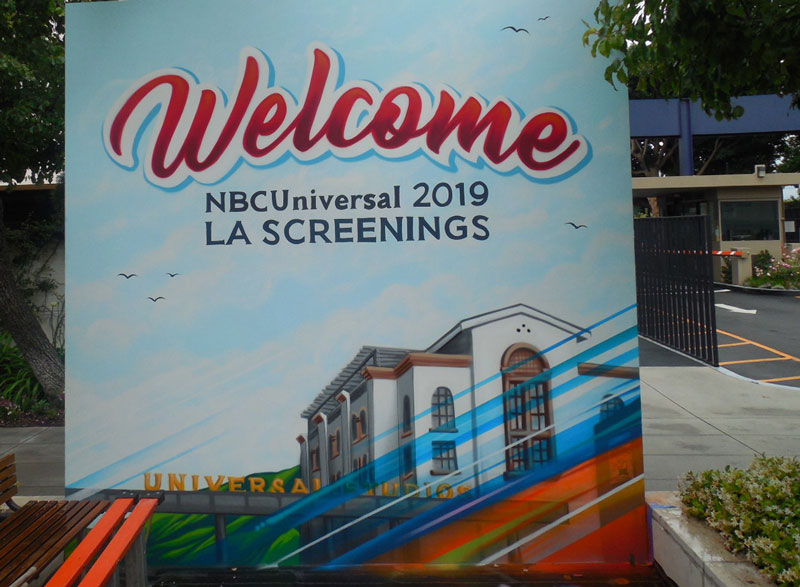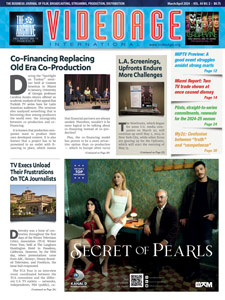At May’s L.A. Screening, buyers kept one eye on the content on offer from the U.S. studios, and the other on developments behind the scenes at the studios that could affect future editions of the L.A. Screenings.
Indeed, there were two recurrent questions on buyers’ lips. First, in light of a new emphasis on OTT services, will studios continue selling their content internationally? And second, will the 56-year-old L.A. Screenings even continue to exist in this new environment?
One major Italian TV buyer who wished to remain anonymous told VideoAge that L.A. Screenings 2019 “could represent the end of an era,” and commented: “We’re witnessing a reduced participation of the U.S. majors at international TV markets. If even the L.A. Screenings assumes a lesser role, how will business be conducted without that direct rapport, which is so fundamentally important in our industry between buyers and sellers?”
During welcoming remarks at the Screenings, a number of studio executives reassured buyers that they will indeed remain open for business. As to the second query, the informal answer was also yes. The L.A. Screenings will continue, they said, but many noted that the event will most likely morph into something different — something that has yet to be envisioned.
Ultimately, the bottom line is this — if the U.S. TV networks continue to commission pilots and hold their Upfront presentations in New York City in May, then the L.A. Screenings will follow immediately after. (And it is on this basis that VideoAge has prepared a preliminary L.A. Screenings 2020 calendar.)
Several statements from top-level U.S. network executives further reassured future L.A. Screenings participants.
According to Lachlan Murdoch, CEO of Fox Corp., which owns the FOX TV network and a group of 28 local U.S. TV stations, the company is expanding its “portfolio of owned and co-owned content,” and FOX will have an equity stake in most of the shows on the network.
Joseph Ianniello, CEO of CBS, told The Los Angeles Times that “We don’t mind selling [our] shows to third parties and taking that money and reinvesting it back into more content for us. If we can make money while we’re still driving the number of [CBS All Access] subscribers, we’re going to continue to do that.”
It is clear, however, that an era of uncertainty is now engulfing the television world. The latest SVoD developments, driven by Wall Street, have left the worldwide film-TV industry in a state of shock and disbelief, especially because there are no clear answers. Now, more than ever, Oscar-winning screenwriter William Goldman’s quote, “Nobody knows anything,” can be applied to show business.
For years, the U.S. studios wanted to “eliminate the middle-man” and go straight to the consumers. This desire was accelerated by the consumer’s (and Wall Street’s) obsession with Netflix. It’s not that the show biz sector necessarily wanted to rush into SVoDs, but when it was explained to Wall Street bigwigs that it would be unwise to give up the assured $11 billion worth of international content sales a year (just by the major U.S. studios combined) for potential SVoD revenue, investors on the Street almost unanimously responded, “Yes, but what about your future digital plans?” And to prove its resolve, the Street gave Netflix unlimited funds, despite the streamer’s $13 billion losses and negative cash flow.
This is notwithstanding the fact that big advertisers keep raising the amount of money they spend on U.S. primetime TV. At May’s Upfronts in New York City, the five major TV networks (ABC, CBS, FOX, NBC, and The CW) secured up to $10.85 billion in primetime commitments, up seven percent from last year.
“This year’s advertising Upfront was one of the strongest we have seen in years,” said Lachlan Murdoch. FOX presold an estimated $1.82 billion of primetime, versus $1.67 billion in 2018.
“I think there is a move back [to TV from digital]. There is a feeling of safety,” said Discovery CEO David Zaslav. Even digital streamers like Amazon and Netflix are now increasingly using TV ads to reach wide audiences.
It is under this evolving scenario that the over 10 major SVoD services in the works are willing to sacrifice the studios’ combined $11 billion in international content sales in order to reserve programming for their own untested streaming services. And, in committing their best original productions to their OTT services, the studios will also be sacrificing a good portion of their broadcast revenues.
In the case of Disney, for example, all its branded content will now go to its new digital platform, Disney Plus, while non-branded programs will end up on Hulu. What’s left will then go exclusively to FOX Channels worldwide, which were acquired from 20th Century Fox (and are separate from the FOX Network in the U.S., which is still owned by Fox Corp.).
In view of these changes, Disney’s international content sales division has been reorganized under the management of Justin Connolly, who will continue to lead Disney’s North American Distribution, Affiliate Marketing, and affiliate-related business operations for all Disney and ESPN services, including Disney Channel and National Geographic. His added tasks include working closely with Disney’s International Content Sales teams who now report directly to their respective regional leaders — Rebecca Campbell (EMEA), Diego Lerner (LATAM), and Uday Shankar (APAC). Connolly is based in New York City and reports to Kevin Mayer, chairman of the Direct-to-Consumer and International division of The Walt Disney Company.
At this point, no one knows if this many streamers will be financially viable in the long term. The industry must wait at least five years to find out (unless the anticipated recession goes into effect during in the early phase of the SVoD launches, which will mean that a negative outcome will be felt much earlier). By then the top brass who made today’s decision to go all in on streaming will most likely be retired, so the ball will be in the courts of new executives, who might never have been fully convinced of the soundness of a streaming-only distribution business.
While the full effects won’t be felt for a while, the first consequences of this rush to SVoD will be clear as early as next year, when the U.S. studios withdraw most of their content from the international TV market, affecting not only TV networks around the world, but trade shows such as NATPE, MIP-TV, and the L.A. Screenings, as well.
While organizations that set up markets such as NATPE and MIP-TV are actively searching for solutions to minimize the fallout, the L.A. Screenings are more vulnerable since it is an organic market piloted by the U.S. studios with no core organization behind it.
All these changes mean that next year, U.S. studios’ at the L.A. Screenings will most likely have much less product than this year, thus the hours spent screening new series at each studio will be drastically decreased. For this reason the number of buyers going to L.A. is expected to be reduced as well.
But these changes could actually be a boon for L.A. Screenings’ indie exhibitors, especially considering the state of uncertainty engulfing MIP-TV, an international TV trade show that next year, and for the first time, will take place in March, at a sufficient “distance” between markets. After all, international TV buyers will still need extra content to fill some or most of their TV network schedules.
As for this most recent edition of the L.A. Screenings, the number of exhibitors at the InterContinental Hotel remained exactly the same as last year — 84 — and some content sellers reported having back-to-back meetings scheduled — especially on Wednesday, May 15, the market’s second day.
With an estimated total of 1,200 buyers, the number of international acquisition executives was definitely lower as compared to last year’s event, but, as one indie seller put it, “the meetings were of a higher quality.”
As usual, the L.A. Screenings started with the indie portion of the market, followed by the studios’ bit. The indie session (which started on Monday, May 13 with the setting up of the hotel’s exhibition suites) began with seminars organized by NATPE, the Los Angeles-based TV trade organization, which were followed by NATPE’s opening party on Tuesday.
Last year, NATPE teamed up with Isabella Marquez to coordinate the set-up of the exhibition suites, organize the seminars, and provide logistics for the six events (i.e., seminars, screenings, and parties) staged at the InterContinental, the organic market’s headquarters.
In terms of revenue, the L.A. Screenings is not yet a moneymaking event for NATPE. It could, however, show some profit if the organization were to “buy” a heavily discounted block of rooms at the InterContinental, rather than get a “room-night” commission on the suites rented to exhibitors. But considering the uncertainty surrounding the international TV business at this time, such a costly move would probably be too risky for NATPE. Then again, for the organization to have a major presence in Los Angeles at the L.A. Screenings represents an insurance policy against potential future disruption at its NATPE Miami trade show in January.
In terms of U.S. studio output, these most recent screenings were undoubtedly skimpy, especially when compared to last year. Out of 65 pilots commissioned, only 35 were selected by the major U.S. broadcast TV networks, with Disney providing the largest output with five dramas and five comedies. Overall, dramas won out over comedies with 21 new series.
In comparison, last year, 76 pilots were com-missioned by the networks, and out of those, 38 were selected for the 2018-2019 broadcast TV season, which ended in May. The official reason given by the networks for this year’s reduced numbers (which were equally divided between fall and midseason series) is to maintain consistency, stability, and reliability.
It even seemed as though network executives were trying to outdo each other with just how little they’d each changed. NBC was proud of a schedule that had altered the least. FOX was happy to have filled a few slots. And CBS execs spoke of the network’s “stability.” To top it all off, the powers that be at ABC seemed to be of the opinion that debuting too many shows would be a disservice to new programs.
The unofficial reason for this could be that the studios, which own the networks, did not want to incur large deficits, which will be recouped in the long run, but represent a drain in the short run, especially during a time when resources have to be re-directed toward direct-to-consumer original programming, and used to repay acquisition investments.
Some of those investments will reportedly be financed by reduced personnel and slashed marketing expenditures. Indeed, some studios are not releasing newly produced movies in order not to incur P&A costs. At the Upfronts, Karey Burke, ABC Entertainment’s president, admitted that “networks don’t have the marketing budgets to launch [new] shows properly.”
Nonetheless, in order to remain relevant, broadcast’s summer schedule is now full of new series, and is no longer the domain of reruns. Indeed, the five main TV broadcast networks have premiered more than 10 new scripted series since May 9 and the start of the new season.
Cost-cutting was also visible at the studios’ screenings. Gone were lunches prepared by the likes of celebrity chefs like Wolfgang Puck. These were replaced by non-branded catering services. On the other hand, Disney served wine for the first time during its luncheons, probably due to its recent acquisition of 20th Century Fox. Wine was always a staple at Fox luncheons in the past. The remaining studio not serving wine during its L.A. Screenings lunch is now Warner Bros.
Disney also did away with its L.A. Screenings opening party. But it’s unclear if this was in order to save money or due to the time-consuming complexity of the integration with Fox. In any case, that function was taken over by Lionsgate, which on Sunday hosted a well-attended opening party at the garden terrace of the Beverly Wilshire Hotel.
Similarly, in the absence of Fox’s traditional closing party, Paramount stepped up with a shindig of its own on its studio lot on Wednesday. (The Fox party would have been held on Thursday in years past, but the L.A. Screenings ended a day earlier this year, hence the Wednesday date for Paramount’s closing party.)
While the studio portion of the L.A. Screenings lost Fox this year, Paramount regained strength with four screenings, which began on Thursday, May 16 with LATAM.
Audio Version (a DV Works service)












Leave A Comment